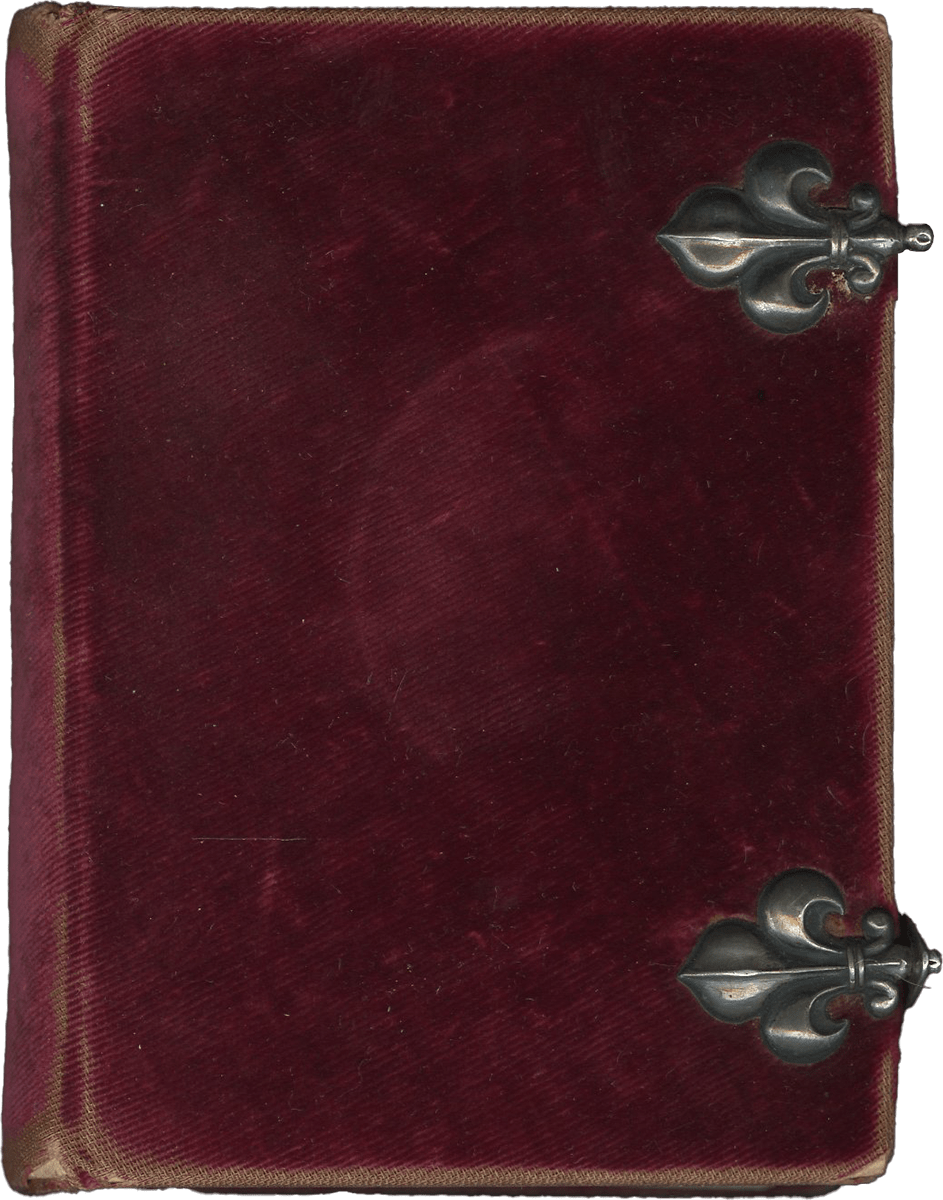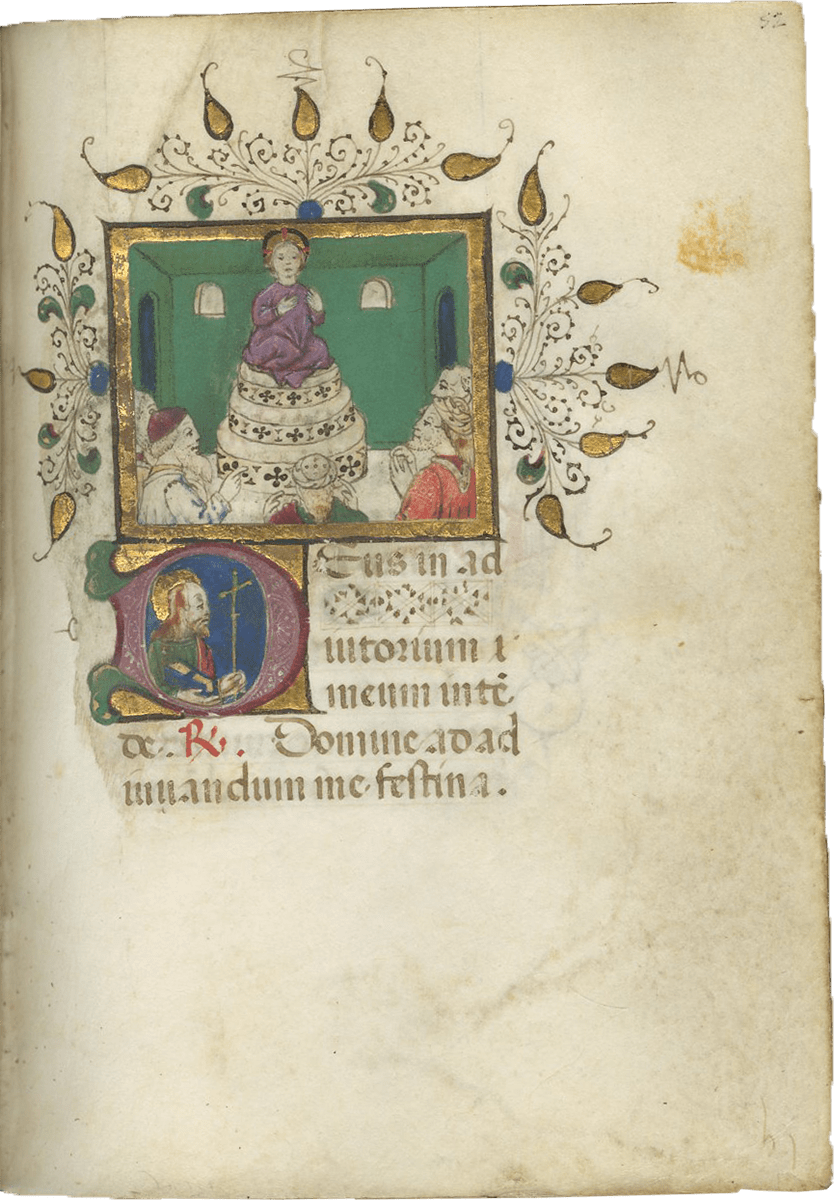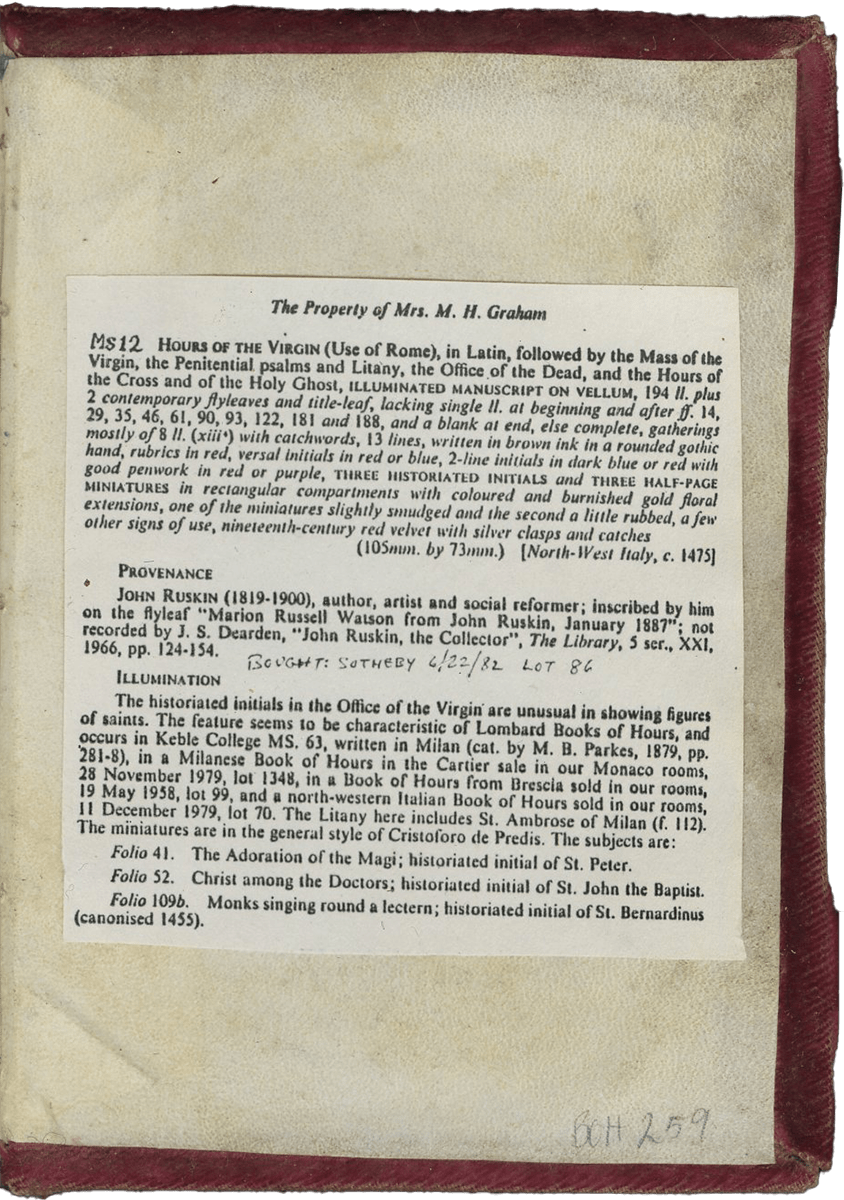


The Ruskin Lombard Hours (use of Rome)
, Lombardy, likely Milan(?), c. 1440–1450




The Ruskin Lombard Hours (use of Rome)




















Description
Once owned by the Victorian polymath John Ruskin, social reformer, art critic, and manuscript collector, this small Book of Hours has considerable charm. Its colorful miniatures, attributed to the circle of the late Gothic artist, Master of the Vitae Imperatorum, coupled with its red velvet binding and metal clasps, convey the sense of intimacy so characteristic of Books of Hours used for devotional purposes.
iii (parchment) + 194 + i (parchment) leaves, foliated in a modern hand in pencil 1–94, lacking single ii at beginning and calendar and after ff. 14, 29, 35, 46, 61, 90, 93, 122, 181, and 188 [collation: i8, ii8-1, iii8, iv8-1, v8-1, vi8, vii8-1, viii8, ix8-1, x8, xi8, xii8, xiii4, xiv6, xv8, xvi8, xvii8-1, xviii8, xix8, xx8, xxi8, xxii8, xxiii8, xxiv8, xxv8-1, xxvi10-1] with catchwords, ruled in one column of thirteen lines (justification 35 × 52 mm) written in brown ink in a rounded gothic textura, rubrics in red, versal initials in red or blue, two-line initials in dark blue or red with good penwork in red or purple, THREE HISTORIATED INITIALS of four lines in purple with white filigree and blue infill on gold ground and THREE HALF-PAGE MINIATURES of seven lines in rectangular compartments with burnished frames and gold floral extension, one of the miniatures slightly smudged and the second a little rubbed, a few others signs of use, else in good condition. Nineteenth-century red velvet binding over pasteboards, with silver fleur-de-lis clasps and catches, minor wear to spine, else in good condition. Dimensions 105 × 73 mm.
PROVENANCE
1. Lombardy, Milan (?). Possibly commissioned for a Franciscan client with decoration on f. 109v featuring a choir of Franciscan monks and a historiated initial with Saint Francis.
2. A seventeenth-century inscription on the second flyleaf records the drawings of lottery numbers. “Le fori del loto il due, et il octo, et il undice [...] metere dentro il [...] il octo il undice il sedice il delsedete.” The lottery originated in Milan in the fifteenth century to help finance a war with the Republic of Venice. In the early seventeenth century, the Lotto di Genova emerged as the first numerically-based lottery system and involved the wagering on the drawing of five numbers out of ninety to bet on the election of city council members. See D. R. Bellhouse, “The Genoese Lottery,” Statistical Science 6, no. 2 (1991), pp. 141–48.
3. Ownership marks (scrapped and illegible) on pastedown with the date 1844 visible.
4. Marion Russell Watson, by gift of John Ruskin (1819–1900), author, artist, and social reformer; inscribed by him on the flyleaf “Marion Russel Watson from John Ruskin, January 1887. Not recorded in James S. Dearden, “John Ruskin, the Collector: With a Catalogue of the Illuminated and Other Manuscripts formerly in his Collection,” The Library 21, no. 2 (June 1966), pp. 124–54. Noteworthy for his attitudes toward manuscript illumination (“Cut up Missal last night, hard work” is one of his famous phrases), Ruskin was a Victorian polymath, author, social reformer, art critic, draftsman, and collector. Could the missing folios in the present manuscript to a product of Ruskin’s enthusiastic sabotage?
5. Mrs. M. H. Graham, her estate sold at Sotheby’s London, June 22, 1982; this manuscript lot 86.
6. Dr. Scott Schwartz, New York, his bookplate and catalog number “MS 12” on front pastedown.
TEXT
ff. 1–41, Hours of the Virgin (beginning imperfectly);
ff. 93v–109, Penitential Psalms (beginning imperfectly);
ff. 109v–122v, Litanies;
ff. 123–181v, Office of the Dead (beginning imperfectly);
ff. 182v–188v, Hours of the Cross (beginning imperfectly);
ff. 188v–194v, Hours of the Holy Spirit (beginning imperfectly).
ILLUMINATION
The subjects of the illuminations are:
f. 41, Adoration of the Magi, half-page, and a historiated initial ‘D’ with Saint Peter;
f. 52, Christ Among the Doctors, half-page, and a historiated initial ‘D’ with John the Baptist;
f. 109v, Franciscan monks singing around a lectern, half-page, and historiated initial ‘K’ of Saint Francis.
Named the Ruskin Lombard Hours (to distinguish it from other “Ruskin Hours,” such as Getty Museum MS Ludwig IX 3), this Book of Hours was almost certainly produced in Lombardy by an artist either in the circle of or a follower of the Master of the Vitae Imperatorum, whose prolific Milanese workshop flourished in the second quarter of the fifteenth century. Its decorative program, featuring illuminations framed in gold boxes alongside historiated initials with saints, is characteristic of Lombard illumination, as seen in examples like Oxford, Keble College MS 63. More significantly, the inclusion of historiated initials with bust-portraits of saints or teachers accompanying framed illuminations is a typical feature of fifteenth-century Lombard and Milanese book illumination. Examples include Biblioteca Apostolica, Chigi Cod. D. IV. 55, also by a follower of the Master of the Vitae Imperatorum and a signed and dated Book of Hours with busts of Franciscan saints illuminated by the Master of the Vitae Imperatorum for a Clarissan nun (Bologna, BUB, MS 1148). The presence of these saints supplants the more common imagery at the start of the major liturgical hours, perhaps offering a focus for personal contemplation.
The style of this manuscript closely echoes that of the Master of the Vitae Imperatorum and his workshop, as seen in a contemporary Book of Hours (Les Enluminures, BOH 101), produced between 1440 and 1450. The contours of the figures’ foreheads, noses, beards, chins, and particularly the nasolabial folds in profile, are strikingly similar to works from this workshop, suggesting a possible origin there. The illumination in a Breviary at the Walters Art Museum, attributed to the Master of the Vitae Imperatorum and likely created around 1430, further exemplifies his style. This illuminator, active in Milan from 1430 to 1453, was a leading artist in Lombardy. Named after a copy of Suetonius dated December 1431 (Paris, BnF MS it. 131), the Master was trained by Tomasino da Vimercate and worked for Filippo Maria Visconti and his court. His known masterpieces include the Bible of Mary of Savoy (with Belbello da Pavia) and illustrations for Dante’s Inferno for Filippo Visconti. Anna Melograni built upon Pietro Toesca’s initial stylistic outline from 1912 to trace the œuvre of this Master (Melograni 1990 and 1996). The present manuscript contributes to our understanding of his workshop’s output and its influence within Lombardy and Milan.
Although lacking five folios, the style of the illumination has great charm, and the small size of the volume, nicely bound in old red velvet with generous margins, conveys an intimacy characteristic of Books of Hours used at home for devotional purposes. Missing miniatures would have opened the following sections, the Hours of the Virgin, Penitential Psalms, Office of the Dead, Hours of the Cross, and Hours of the Holy Spirit.
LITERATURE
Unpublished; for Related literature:
Lollini, Fabrizio. “Maestro delle vite degli imperatori” in Dizionario biografico dei miniatori Italiani: Secoli IX–XVI, ed. Milvia Bollati, Milan, 2004, pp. 587–89;
Manzari, Francesca. “Libri d’ore e strumenti per la devozione italiani e nordeuropei nel Tardo Medioevo: Temi e aspetti della ricerca e della catalogazione,” in La catalogazione dei manoscritti miniati come strumento di conoscenza, Rome, 2010, pp. 141–60;
Manzari, Francesca. “Italian Books of Hours and Prayer Books in the Fourteenth Century,” in Books of Hours Reconsidered, ed. Sandra Hindman and James H. Marrow, London, 2013, pp. 153–209;
Manzari, Francesca. “Pour une géographie des aires de production des livre d’heures en Italie au XIVe siècle: État des recherches et nouvelles acquisitions,” in Des Heures pour prier: Les Livres d’heures en Europe méridionale du Moyen Age à la Renaissance, ed. Christaine Raynaud and Michel Pastoureau, Paris, 2014, pp. 21–41.
Melograni, Anna. “Appunti di miniatura lombarda: Richerche sul Maestro delle Vitae Imperatorum,” Storia dell’Arte 70 (1990), pp. 273–314;
Melograni, Anna. “Due nuovi codici del Magister Vitae Imperatorum,” Aevum 70 (1996), pp. 295–301;
Toesca, Pietro. La Pittura e la Miniatura nella Lombardia, Milan, 1912, p. 528;
ONLINE RESOURCES
Italian Books of Hours/Libri d'ore italiani, by Francesca Manzari with Lola Massolo
https://sites.google.com/view/libridoreitalianimanzari/home-page
We thank Peter Bovenmyer and Milvia Bollati for assistance on this description.